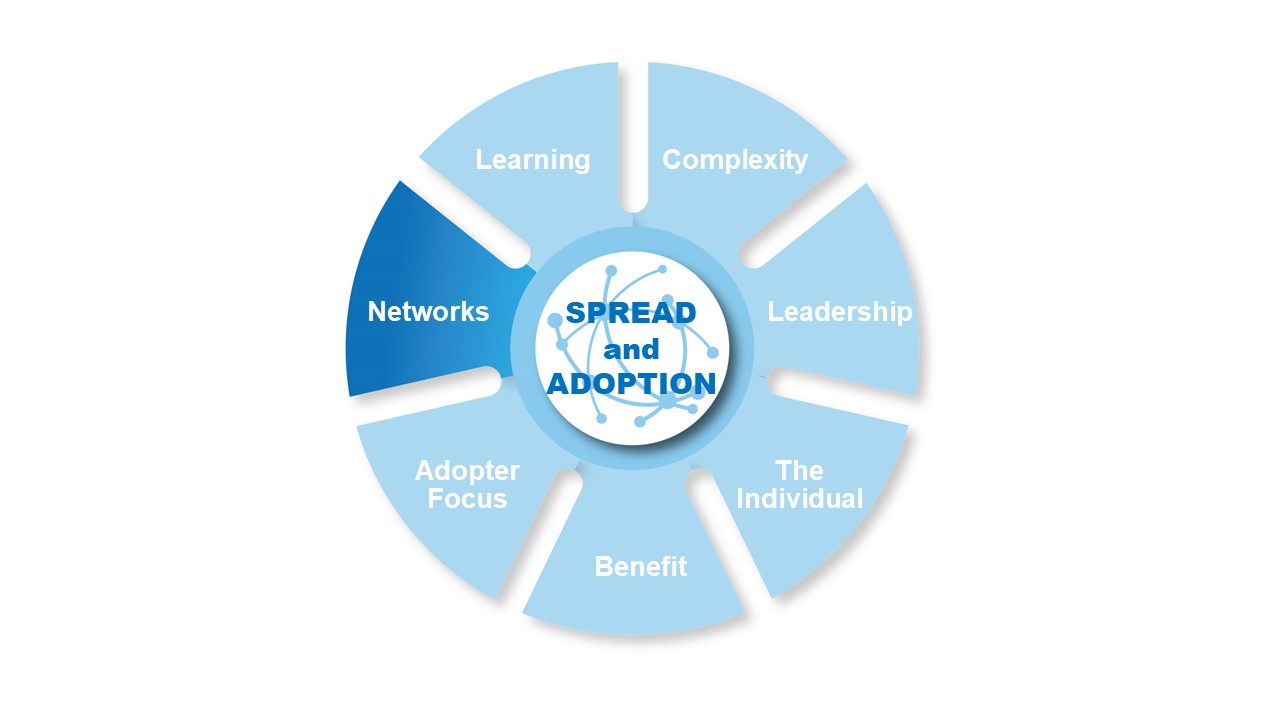The recently launched Guide, Leading the Spread and Adoption of Innovation and Improvement: A Practical Guide, offers seven interconnected principles. This blog is the sixth in a series of blogs, each focusing on one of the seven principles and this one focuses on networks.
These principles represent important aspects to consider for spread and adoption and are explained in the Guide. All the seven principles are important; they are interconnected, each will have a different importance and require different actions in different settings. Relational, interpersonal elements of spread and adoption – looking at how people can work together – is a common thread within each of the principles.

Utilising networks to build communities, energising and connecting individuals
Spread is a social process, dependent on both social and technical aspects of change. Increased connectivity leads to increased change and spread - this is why networks are so important. Networks enable connections and relationships between individuals – increasing communication, interaction and collaboration and the flow of knowledge and learning as well as development of communities. See the learning principle for more information.
We are all part of a broad range of networks, and communities of practice – formal / informal, professional /topic /social focused, local /national / international, face to face / virtual, all of which can offer different opportunities. Different networks will have a different membership and purpose so it's important to understand which networks, and communities of practice, may be of help in spreading and adopting the innovation, as well as providing mutual support.
To maximise these networks, identify and connect with individuals who have key roles in them e.g. brokers, central-connectors, energisers. See learning and connecting across systems in further resources section of the Guide for more information.
Networks are important not just in the generation of an innovation but also in the acceptance, adoption and adaptation of the innovation in practice, as described in Planning For Spread and Adoption From The Start: A Novel Model For Success.
We can create a 'Pull' for the innovation by sharing the benefit of the innovation, generating motivation and enabling participation to build a crowd or community to provide the energy for spread and adoption and to build and maintain momentum. Harness the energy especially the social, psychological, spiritual energies for change that networks can generate. Recognise how networks can enable local agency and support new power activities by building energy and momentum, particularly via social media and support their use eg platforms like WhatsApp, Slack and social media eg Twitter and Facebook groups, to enable large scale spread.
Technology and social media enable connectivity across many systems and networks building strong links and loose links and a spectrum of allies (people to both support and constructively challenge), which are important in the spread and adoption of innovation. Support the development of networks and encourage networks to connect with other local or national networks e.g. Q community, School for Change Agents, connecting across systems and organisations. Encourage membership of networks and communities of adopters and the connection of these networks with similar local / national networks including professional or special interest networks. A movement can grow and gain support from many small-group networks.
More details on Networks in the leading and connecting across systems in further resources.
Image by Gerd Altmann from Pixabay
Applying this principle to practice
The Guide offers a list of questions to help apply this work to practice. The questions will be of varying relevance depending on the particular context. Some of the questions are:
- What existing networks can you work with or connect to?
- Who does / can play key roles in the networks?
- Who is currently in your network? To enable spread and adoption who needs to be in your network? How will you fill any gaps?
- How can you harness the energy and agency generated by networks?
- How can you support network building mechanisms e.g. platforms, groups, social media?
- How can you encourage membership of a network?
- What opportunity is there to connect existing relevant networks?
- How can you support development of a network?
You may find the following tools and methods helpful:
- Source for Networks – Learning Space, diagnostics [core questions and maturity matrix] and resources and leading and connecting across systems
- Network weaving and Working Out Loud
- Social media
- Agency
also see practical tools and methods, further resources and systems convening in the Guide. See Glossary for explanation of terms.
These seven interconnected principles can be used by individuals, or by a team, and at all levels; local, regional and national and settings where the spread and adoption of complex change is needed. These principles can be used to inform planning and to inform ongoing reviews.
This blog Introduction to the Seven Interconnected Principles for Spread and Adoption offers an overview of all seven principles.
Details of how these principles apply to the work we do are described in How the Seven Spread and Adoption Principles Work in Practice: the Continuing Healthcare Improvement Collaborative case study.
Want more information?
More details on the Network principle, the seven interconnected principles and systems convening, in the Leading the Spread and Adoption of Innovation and Improvement: A Practical Guide and on the NHS Horizons website including blogs and videos.
If you're interested to read more there are previous blogs and further blogs to follow. Please do subscribe to this blog and follow @DianeKetley @HorizonsNHS, #NHSSpread.
We would love to hear your feedback about the Guide, and how you will use it. Send a tweet to @DianeKetley @HorizonsNHS #NHSSpread. If you prefer email, get in touch at England.si-horizons@nhs.net.
Image by Gerd Altmann from Pixabay




/Passle/5a5c5fb12a1ea2042466f05f/MediaLibrary/Images/6168334917af5b10f4bf1d30/2022-04-14-15-27-52-040-62583d78f636e9115805b2d5.png)
/Passle/5a5c5fb12a1ea2042466f05f/MediaLibrary/Images/6168334917af5b10f4bf1d30/2022-08-05-09-59-36-465-62ecea08f636e906acfed639.jpg)
/Passle/5a5c5fb12a1ea2042466f05f/MediaLibrary/Images/6168334917af5b10f4bf1d30/2022-07-28-14-57-17-405-62e2a3cdf636e9180c9835cb.png)
/Passle/5a5c5fb12a1ea2042466f05f/MediaLibrary/Images/6168334917af5b10f4bf1d30/2022-07-20-10-16-56-533-62d7d618f636ea07987f6668.png)
/Passle/5a5c5fb12a1ea2042466f05f/MediaLibrary/Images/6168334917af5b10f4bf1d30/2022-07-15-09-55-32-858-62d13994f636ea1398e71aa9.jpg)